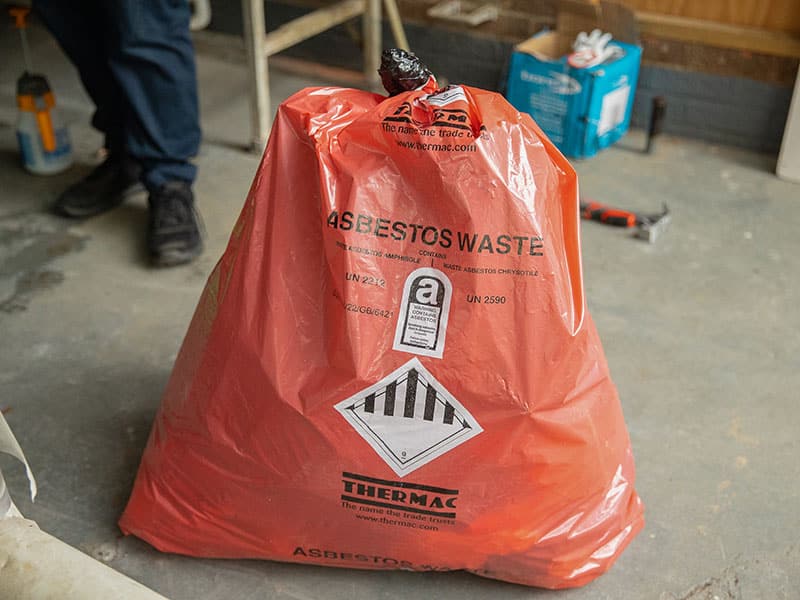What is Asbestos Clearance Certification?
If you have spent much time at all educating yourself on the multitude of risks that asbestos-containing materials (ACMs) can pose on a commercial, public, or residential site, you will hopefully also appreciate that a far-reaching clearance process is vital following asbestos removal work.
Indeed, a fastidious, four-stage asbestos clearance process is not merely needed for its own sake and for helping to ensure the utmost safety of the given premises for reoccupation.
That’s because it is also necessary as a means of showing that asbestos removal work has been completed on the site in line with regulatory requirements.
What is asbestos clearance certification?
Following the completion of licensed asbestos removal – in other words, a process of removing asbestos from a site for which a Health and Safety Executive (HSE) asbestos licence was required – it is necessary to arrange for a four-stage asbestos clearance.
Having such a clearance process carried out will serve as confirmation that the work done complies with the requirements of the Control of Asbestos Regulations 2012 (CAR 2012). Once the four-stage asbestos clearance has been successfully completed, a certificate of reoccupation (sometimes referred to as an “asbestos clearance certificate”) will be issued.
Until this certificate of reoccupation has been issued for an area where licensed asbestos removal work was carried out, no one will be able to safely enter that area (unless, of course, they are wearing suitable personal protective equipment, or PPE).
What are the four stages of asbestos clearance certification?
The following are the typical stages of the four-stage asbestos clearance process that are necessary for a certificate of reoccupation to be issued:
Stage 1: Asbestos removal process
It is typically recommended that those seeking out authorised assessors to carry out the clearance certification process choose a company that is independent from the one that undertook the asbestos removal work.
Part of the reason for this is because one of the first things the analyst you hire will need to do, is establish the scope of the asbestos removal work, and determine whether that work was done accordingly. This will be followed by a visual inspection of the site, as we detail below.
Before even that happens, however, you will need to arrange for the asbestos removal itself to be undertaken. We have written previously here at Oracle Solutions about how to find the right asbestos removal company for your needs, touching on such aspects as whether they are suitably licensed, the insurance they hold, and their industry accreditations, knowhow, and experience.
Making sure those factors are right will help ensure your chosen asbestos removal contractor handles, removes, and disposes of asbestos from your site in a professional manner that also complies with the UK’s stringent asbestos safety requirements.
Hiring an asbestos removal company that practises such high standards will help ensure you eventually obtain that all-important asbestos clearance certification.
Stage 2: Initial inspection
As we touched on above, for the initial inspection of the site where asbestos has been removed, it will greatly help if you hire a certified professional who is independent from the asbestos removal company.
This analyst is likely to look at the asbestos removal contractor’s licence, notification, training, equipment, and other records, alongside examining the site files to make sure all associated information is present and up to date.
Once these steps are done, the assessor will typically conduct a visual inspection of the site. This will entail them checking that the removal enclosure is intact and the decontamination facilities are operational.
They will also look at the main affected area, as well as the transit and waste routes, to make sure there isn’t any unnecessary clutter or obvious asbestos contamination that occurred as a consequence of the asbestos removal work.
Once these aspects have been checked, and confirmed to be to the assessor’s satisfaction, they will be able to proceed to carry out a more thorough visual inspection of the enclosure and work area.
This stage of the process will entail the analyst keeping a lookout for any fallen debris or other residual material. They will be scrutinising all parts of the enclosure, including the airlocks and bag locks, to make sure there isn’t any lingering dust or debris.
Stage 3: Air monitoring and testing
It will then be time for testing and analysis for asbestos fibres to be carried out in the space. This will entail, at the start of the sample run, the work enclosure being brushed in order to disturb any unseen, fine-settled dust that could stand a strong chance of containing asbestos fibres.
Such dust can be a cause for concern, given the scope it presents for a high level of asbestos exposure to occur when the enclosure is being dismantled, as well as during the ensuing cleaning and maintenance activities in the work area.
Filters will be used to collect the samples, with these then being taken from the enclosure, followed by on-site counting using phase contrast microscopy (PCM). The clearance air test will be conducted under disturbance to simulate normal occupation conditions, and the analyst will be looking to ensure the standard of less than 0.01 asbestos fibres per cubic centimetre of air is satisfied.
In the event of this requirement being met, and the assessor determining that the space is suitably clean, they will be able to sign off stage three in readiness for dismantling of the enclosure.
Stage 4: Final assessment and certification
Presuming the air test brings a positive result, it will be time to dismantle the enclosure and remove all equipment and materials from the space.
Given that even the final taking-down of the enclosure could cause some leftover asbestos fibres to be released – for example, if such fibres were trapped within the enclosure material’s folds – it is important for the analyst you have hired to do one last check and assessment.
This final assessment will also include the assessor looking over the general area and revisiting the transit and waste routes, so that they can be absolutely clear there are no residual problems.
If any minor issues do come up at this stage, they can normally be cleaned with ease prior to the completion of the fourth stage. However, in extreme cases (which are thankfully also very rare), there may be a need to reinstate the enclosure to allow for the work to be redone.
Once the analyst is satisfied with the cleanliness and safety of the space, the fourth stage can finally be signed off. This will, at last, allow for a certificate of reoccupation to be issued. This certificate will show information on any failures and remedial actions that turn out to be needed.
Who issues the asbestos clearance certificate?
An asbestos certificate of reoccupation (also known as an asbestos clearance certificate) is defined as a document that is issued by an organisation holding United Kingdom Accreditation Service (UKAS) accreditation after the removal of asbestos by a licensed contractor. So, it is vital to make sure whatever company you choose to provide such a certificate has this accreditation.
There are certain qualifications that you can expect such a company’s site analysts to have. These include:
- The P403 Air Sampling and Fibre Counting qualification, which equips analysts with the knowledge and skills they require in order to safely take air samples, prepare fibre counting slides, and accurately analyse such slides under a microscope
- The P404 Clearance Testing and the Requirements of a Certificate for Reoccupation qualification, which is the industry standard for asbestos site analysts. Successful completion of this course will give analysts the skills and knowledge they need in order to thoroughly and safely carry out all four stages of the asbestos clearance process.
To reaffirm what we said earlier in this article: choosing a company to undertake the asbestos clearance certification process that is independent of the asbestos removal contractor is crucial, as it will enable you to be confident in the objectivity of their work. This, in turn, will allow you to be surer of achieving genuine compliance with the requirements of the relevant asbestos legislation.
How important is asbestos clearance certification?
Asbestos is a notoriously dangerous substance. Banned from being used in the UK since 1999, asbestos is associated with the development of potentially fatal diseases, such as mesothelioma or asbestos-related lung cancer, in those who ingest or inhale this mineral’s lethal fibres. Around 5,000 deaths a year in the UK can be attributed to asbestos-related disease, even in the 2020s, largely – but not entirely – due to incidents of asbestos exposure that occurred many decades earlier.
So, you can probably begin to appreciate just how critically important the asbestos clearance certification process is for ensuring the very greatest possible safety, legal compliance, and peace of mind.
With an asbestos certificate of reoccupation – as issued by a UKAS-accredited organisation – serving as a reliable indicator that asbestos has indeed been removed from a particular space in a property where it was once present, this certification could help boost the value of your property. Furthermore, it could help lower the cost of insuring the building, and/or make insurance easier to obtain, due to your property being perceived as a lower risk following the removal of asbestos.
Conclusion: asbestos clearance certification makes a major contribution to compliance and safety
The four well-defined stages of the asbestos clearance certification process will play a major role in ensuring the safety of a given site after asbestos has been removed from it. An asbestos certificate of reoccupation will also show that asbestos removal work on the given site has been carried out in a legally compliant way, alongside delivering the utmost peace of mind to property owners and other stakeholders.
So, you will have hopefully been given a strong sense from this guide of the vital contribution the asbestos clearance certification process makes in an extremely broad range of settings.
To learn more about this process and to enquire about any of our own asbestos services here at Oracle Solutions, please don’t hesitate to give us a call, or to send us an email.

Written by Mark Carter
Mark Carter is a renowned expert in asbestos management, offering clients vital guidance on compliance and safety. His expertise is invaluable for navigating asbestos regulations, ensuring both safety and legal adherence. Mark's role is central in providing effective asbestos-related solutions, helping clients achieve their business objectives with an emphasis on regulatory compliance and safety in asbestos management.

